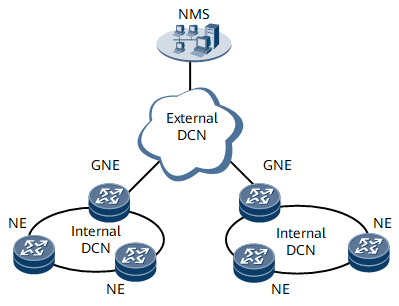Overview of DCN
Definition
The data communication network (DCN) refers to the network on which network elements (NEs) exchange Operation, Administration and Maintenance (OAM) information with the network management system (NMS). It is constructed for communication between managing and managed devices.
Gateway network elements (GNEs) are connected to the NMS using protocols, for example, the Simple Network Management Protocol (SNMP). GNEs are able to forward data at the network or application layer. An NMS directly communicates with a GNE and uses the GNE to deliver management information to non-GNEs.
Purpose
When constructing a large network, hardware engineers must install devices on site, and software commissioning engineers must configure the devices also on site. This network construction method requires significant human and material resources, causing high capital expenditure (CAPEX) and operational expenditure (OPEX). If a new NE is deployed but the NMS cannot detect the NE, the network administrator cannot manage or control the NE. Plug-and-play can be used so that the NMS can automatically detect new NEs and remotely commission the NEs to reduce CAPEX and OPEX.
The DCN technique offers a mechanism to implement plug-and-play. After an NE is installed and started, an IP address (NEIP address) mapped to the NEID of the NE is automatically generated. Each NE adds its NEID and NEIP address to a link state advertisement (LSA). Then, Open Shortest Path First (OSPF) advertises all Type-10 LSAs to construct a core routing table that contains mappings between NEIP addresses and NEIDs on each NE. After detecting a new NE, the GNE reports the NE to the NMS. The NMS accesses the NE using the IP address of the GNE and ID of the NE. To commission NEs, the NMS can use the GNE to remotely manage the NEs on the network.

To improve the system security, it is recommended that the NEIP address be changed to the planned one.
Benefits
The NMS is able to manage NEs using service channels provided by the managed NEs. No additional devices are required, reducing CAPEX and OPEX.
